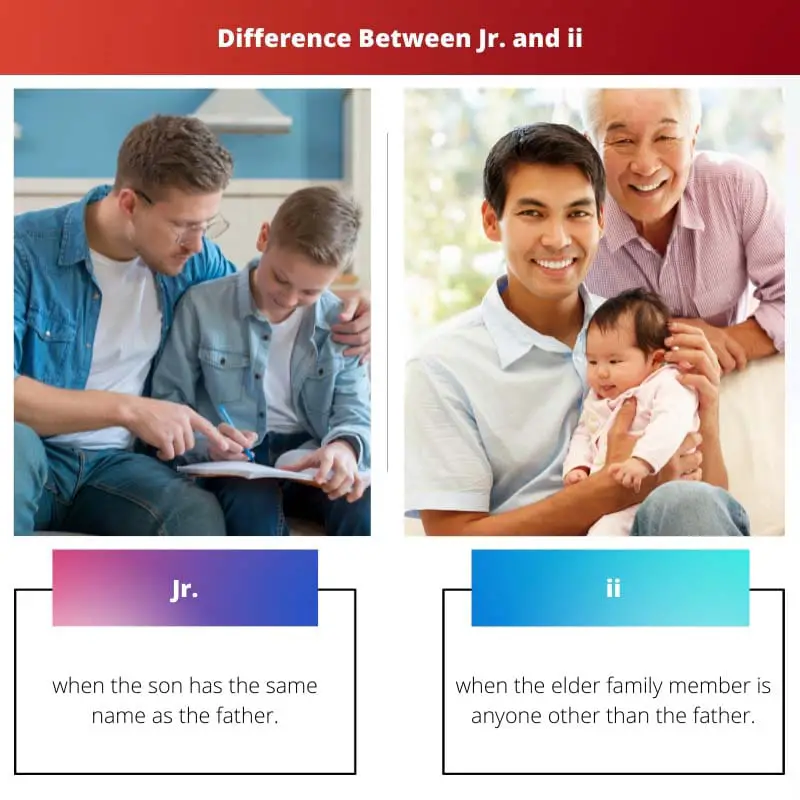A suffix is very common in the English language. Adding a suffix after the name is prevalent in the Western English world. It is a tradition where after the person’s full name, the suffix is added so that it gives additional information about that person.
Initials placed after the suffix is also referred to as post-Nominal letters.
It indicates that a person holds an educational degree, accreditation, office, position, or honour etc. besides that there are generation or genealogy designations given to individuals.
It includes Sr. and Jr. and I, II, III, etc. Jr. and ii are part of generational suffixes.
Key Takeaways
- “JR” stands for Junior, used when a son shares the same first, middle, and last name as his father.
- “II” is used when a family member has the same name as a relative but is not a direct descendant, like an uncle or grandfather.
- Both designations distinguish between individuals with the same name, but “JR” is for direct lineage, while “II” is for extended family members.
Jr. vs ii
The suffix “Jr.” is added to a person’s name to denote that he is a son who shares his father’s name, it is normally used during one’s lifetime. The suffix “II” denotes that a person has the same name as their father, but it does not necessarily imply a father-son relationship. , “II” can be used both during and after one’s lifetime.

Jr. represents Junior. Jr. is a very common suffix that can be found. In the USA, Jr. is a very common suffix with the initial capital letters. But in the United Kingdom, Jr. are not so common.
They are used very rarely. Jr. is used as etiquette, and it is not written in any law. According to the law, the son uses the Jr. suffix when his and his father’s names are the same. The father should be a living person.
So that a distinction can be made between the two, but the name of both father and son doesn’t need to match. Jr. can be used informally as well.
ii represents ‘the second’. This suffix is more prevalent in the united kingdom. Any male member of the family can use the second if he shares the same name with his elder member. An elder member may include a grandfather, uncle, cousin etc.
But it should not be his father. It is not capitalized like Jr. When giving the suffix ‘the second,’ the name should be the same as it was added to give honour to the deceased person. In Uk, it is used formally.
Comparison Table
| Parameters of Comparison | Jr. | ii |
|---|---|---|
| Represents | Junior | The second |
| Purpose | when the son has the same name as the father. | when the elder family member is anyone other than the father. |
| Condition | Father should be living. | To honour the deceased person. |
| Situation | Formal and Informal | Formal |
| Usage | Prevalent in the USA and in modern times. | Prevalent in the UK. |
What is Jr.?
Jr. indicates that a person is named after his father. In the olden days, when there was a high child mortality rate, there was a tradition of naming the child.
It was very common to name the son after his father in the hope that he would follow in his father’s footsteps and do good things. There is no rule enshrined by law that which child should be given the title of Jr.
It completely depends upon the family or an individual who wants to take Jr. There are some of the rules unofficially followed while naming a child Jr.
It includes that a father should be a living person if the son is called a Jr. Or it may also happen that Sr. (Senior) must have died. Then only it can take up Jr. Or when Jr. child has got married. Usually, it is expected that Jr. is named after the father.
He should be alive. Sometimes after repeating the same name for generations, it does not matter whether the original Sr. is a father or any other male relative.
What is ii?
Everybody wants his or her child to be like his or her father or a respected family member. Naming the children ‘the second’ is done to remember the eldest or the dearest member and to pay respect to him.
Mostly it was done for the Kings and Queens. We can find in history numerous examples when there were named as ii, like Henry II, Edward II, etc.
Usually, it is used when a child is named after other members like his uncle, grandfather, maternal grandfather, nephew etc.
ii suffixes were mostly used for the rulers so that it can be easy to memorise and write the names in the royal family trees. A child can also be named as ‘the second’ by his mother if his father has died before his birth.
It can be seen in girls and women too. However, in the modern era, its usage is very rare. In previous times, it was prevalent in England.
Main Differences Between Jr. and ii
- Jr. represents Junior; the first letter is capitalised with or without a comma. II represent ‘the second’. It is not capitalised.
- The purpose of using the Jr. suffix is when the son has the same name as the father. The purpose of using ii suffixes is when the elder family member is anyone other than the father.
- The condition for using Jr. suffix is that the father should be living. The condition for using ii suffixes is to honour the deceased person.
- Jr. can be used in both formal and informal ways. ii can be used only in formal situations.
- Usage of Jr. is prevalent in the USA and in modern times as a fashion. Usage of ii is prevalent in the UK among girls or ladies. But in the modern era, it has become rare.

- https://periodicos.ufmg.br/index.php/jidm/article/view/152
- http://infor.seaninstitute.org/index.php/pendidikan/article/view/48

Jr. and ii are still in use today as ways of showing a person’s background without the need for asking personal questions. The article gives a good overview of the differences between these very similar titles.
The article is enlightening in its detailed comparison of ‘Jr.’ and ‘ii’. I especially appreciate the insights into the origins of such suffixes.
The author’s engaging writing style makes the history of these suffixes an enjoyable and informative read.
This article provides a fascinating insight into the historical and cultural nuances of ‘Jr.’ and ‘ii’.
The detailed comparison gives a comprehensive understanding of the uses and implications of ‘Jr.’ and ‘ii’.
The article is too focused on the past and is overly intellectual, making it tedious and inaccessible to many readers.
The article is very thorough in explaining the history and usage of ‘Jr.’ and ‘ii’. It’s interesting to know that ‘Jr.’ is used for direct lineage, while ‘ii’ is used for extended family members.